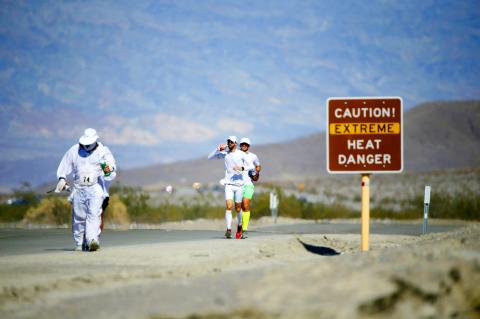Running 217km through the searing summer heat of Death Valley in California before ending the route with a cumulative gain of 15,181m to reach the slopes of Mount Whitney?
Slogging across four desert courses, each 241km long, in Chile, China, Egypt and Antarctica in what is known as the Four Deserts Grand Slam?
Racing against the clock through 75 control points in the footsteps of ancient Athenian messenger Pheidippidis, with a cut-off of 36 hours to complete the 246km Spartathlon?

Photo: Reuters
Risking dehydration, exhaustion, broken ankles, kidney failure or the need to throw in the towel and give up — all possible reasons for an athlete to abort the grueling challenge of an ultramarathon?
For the uninitiated, all of the above scenarios suggest a twinning of sadism with sheer lunacy. However, for the ultramarathoner, it is all about running for joy, setting personal goals and trying to overcome every obstacle faced.
“People are intrigued by the thought of someone wanting to run 100 miles [160km], or more,” experienced ultramarathoner Shannon Farar-Griefer, who has five times raced the grueling Badwater 135 across Death Valley, told reporters. “They might say: ‘What’s wrong with you that you want to run 100 miles? Were you abused, or were you a drug addict?’ We just love to run. It’s all about passion in this sport.”
“You know you’re going to hurt, you know you’re going to have a long day,” Farar-Griefer said. “That’s why people think that we are a little different from the rest, because we keep pushing our bodies. Ultras are all about learning how to be able to accept pain.”
An ultramarathon involves a combination of running and walking further than the traditional marathon of 42.2km. Though most ultras cover distances of either 80km or 160km, many are much longer.
For Connecticut-based running coach Tom Holland, an exercise physiologist and certified sports nutritionist who has competed in more than 60 marathons and 21 triathlons, ultras are all about achieving objectives.
“It’s the innate human desire to push our limits,” Holland told reporters. “I believe many people find incredible personal satisfaction in achieving these challenging goals. They run a marathon or three and then have a need to push their bodies even further, both physically as well as mentally. Pushing through periods of incredible discomfort and coming out on the other side is extremely empowering.”
Holland is a veteran of several ultras, including the Run to the Sun, a 58km journey to the 3,055km-high summit of Haleakala on the island of Maui, and he regards the ultra challenge as a metaphor for life.
“You realize that no matter how bad you think things are at the time, you are strong enough to push through them and things will always get better,” he said.
Australian Samantha Gash, the first woman to complete the Four Deserts Grand Slam in a calendar year, said that ultramarathoners share a burning desire to be the best they can be while often competing well outside their comfort zones.
“The people who finish are not the most physically fit, but the ones that are mentally strong, those who don’t entertain the possibility of not finishing,” she said.
Gash, who is featured in a documentary released last year called Desert Runners, which chronicles the Four Deserts Grand Slam, gained a massive jolt of self-belief after her pioneering accomplishments in Chile, China, Egypt and Antarctica.
“Being [previously] a nobody in the world of ultra running, if I could do something of this size and scale, it makes you feel that anything’s possible,” she said of her success in the Four Deserts Grand Slam.
“There were moments when I wondered what I was doing, when I was so dehydrated it hurt. I felt new depths of pain, but I really never let myself contemplate giving up,” said Gash, who had to contend with heat, cold, dehydration and extreme fatigue in some of the world’s most hostile environments while running with supplies strapped to her back.
Farar-Griefer, a 53-year-old mother of three who lives in Hidden Hills, California, and took up long-distance running at the age of 39, has no doubt about her most brutal ultra experience.
“The 292-mile Death Valley Badwater double, by far,” Farar-Griefer said, referring to her feat in becoming the first female to complete the “double” by finishing the 135 ultra, then making it to the summit of Mount Whitney before returning to the race’s original start.
“All the other runners finished at the portals of Mount Whitney, but I continued on and I summited Mount Whitney and then I ran back. It was 130o [54oC] on the way back,” she said. “At mile 270, I got an edema really bad. I was swollen, I couldn’t pee. It was scary because you could go into total renal failure at that point. Thank God I had a very experienced crew.”
“It’s a sport where you have to be able to endure pain and you have to be comfortable stepping out of your comfort zone,” she said. “It’s a constant mind battle. I love it.”

Japanese badminton star Chiharu Shida on Tuesday told Chinese fans to “stop stalking” her, adding that she was “very scared” by the unwanted attention. Shida, who won women’s doubles bronze at the Paris Olympics last year, has a strong following in China partly because of her engagement with the local culture. The 27-year-old, currently competing at the Badminton Asia Championships in Ningbo, China, has been dubbed the “Badminton Goddess” by fans and media. She hit out at some supporters on Tuesday, accusing them in an Instagram post of taking their fandom too far. “Every time we compete in China we always experience the harm

Two people died on Thursday after fans and police clashed outside the Estadio Monumental in Santiago ahead of a game in South America’s Copa Libertadores, Chilean authorities said. The fatalities happened shortly before the match between Chile’s Colo-Colo and Brazilian club Fortaleza, when police blocked about 100 fans when they attempted to enter the stadium. There were conflicting accounts of how the fatalities occurred, with local media reporting that one of the dead was a 13-year-old boy. The other victim was an 18-year-old woman, according to a relative at the hospital where she was treated. The fans died after being caught underneath a

Paris Saint-Germain (PSG) have shown the team do not need star power to win trophies and with the French Ligue 1 title won with six games to spare, the French champions would look to finish the season without losing, manager Luis Enrique said on Saturday. A 1-0 victory over Angers SCO at the Parc des Princes helped PSG win their fourth straight Ligue 1 title and a record-extending 13th overall. PSG can still break Nantes’ 30-year-old record of 32 games unbeaten. Although Nantes lost one game en route to the title, no French club has ever gone an entire league

A potential European league could be a gold mine for the NBA as the top-flight North American league looks to muscle its way into a deep pool of talent across the Atlantic Ocean. The NBA is exploring the launch of a European league with world basketball governing body FIBA as a partner, NBA commissioner Adam Silver said last week, with an eye toward a 16-team format made up of 12 permanent clubs and four qualifiers. The continent’s longstanding Euroleague quickly signaled its readiness to enter into talks with the NBA, even as it has balked at the idea of another league in